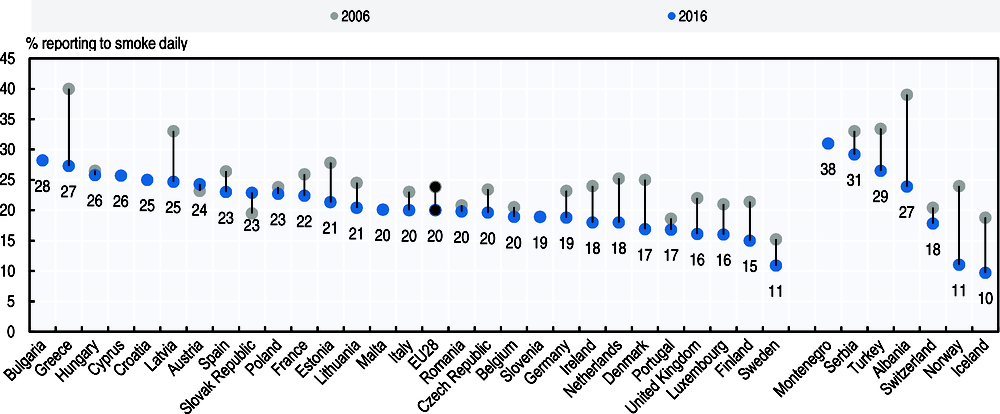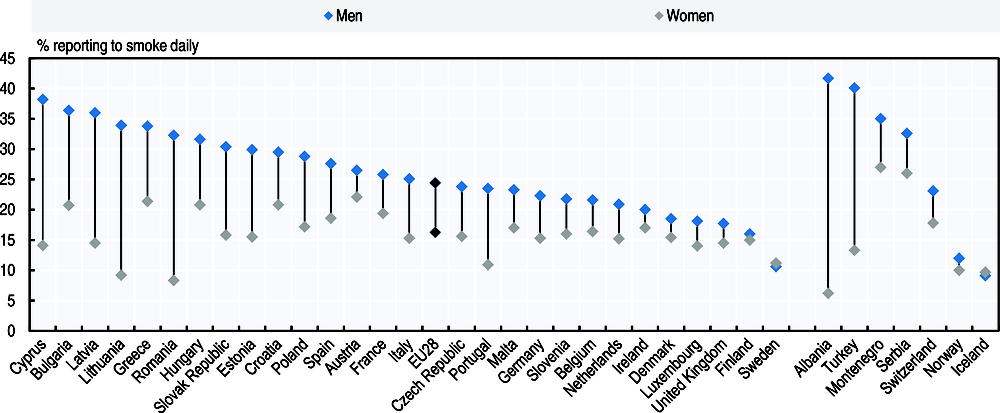Smoking among adults
Tobacco consumption is the largest avoidable health risk in the European Union and the most significant cause of premature death, with over 300 000 deaths per year according to IHME estimates (IHME, 2018). Around half of smokers die prematurely, dying 14 years earlier on average. It is a major risk factor for at least two of the leading causes of mortality, circulatory diseases and cancer, and an important risk factor for many serious respiratory diseases.
The proportion of adults who smoke daily varies more than two-fold across EU countries (Figure 4.3). It is the lowest in Nordic countries (Sweden, Finland, as well as Iceland and Norway) and the highest in Bulgaria, Greece, Hungary and Cyprus. On average, the proportion of adults smoking daily has decreased from 24% in 2006 to 20% in 2016, with large reductions in Nordic countries, the Netherlands, Latvia and Greece.
Men smoke more than women in all European countries, except in Sweden and Iceland where the rate is virtually equal (Figure 4.4). One in four men and one in six women smoke daily on average in EU countries. The gender gap is particularly large in Cyprus, Latvia, Lithuania and Romania.
The Eurobarometer survey reports higher smoking rates among both men and women as it includes people smoking daily or occasionally. The results from the latest Eurobarometer survey conducted in 2017 indicate that 30% of men and 22% of women are daily or occasional smokers on average across EU countries (TNS Opinion & Social, 2017).
According to a tobacco control scale from the Association of European Cancer Leagues, the United Kingdom, Ireland, Iceland, France and Norway are the top five European countries with the most comprehensive tobacco control policies in 2016 (Joossens and Raw, 2017). Countries that have stricter tobacco control policies generally have higher reductions in smoking rates and higher quit ratios (Feliu et al., 2018), although there are exceptions.
The EU Tobacco Products Directive (2014/40/EU), adopted in February 2014, requires that health warnings appear on packages of tobacco and related products, bans all promotional and misleading elements on tobacco products, and sets out safety and quality requirements for electronic cigarettes (European Commission, 2014). One important step forward in health warnings is plain packaging for tobacco products aiming to restrict branding. Following the lead from Australia, plain packaging has been adopted by an increasing number of European countries (e.g. France, Hungary, Ireland, the United Kingdom, Norway, and will be implemented in Slovenia in 2020).
Among tobacco control measures, rising taxes on tobacco is the most effective way to reduce tobacco use and to encourage users to quit (WHO, 2017). The EU Directive on excise duty on tobacco (2011/64/EU), which requires Member States to levy a minimum rate of excise duties on cigarettes (European Commission, 2011), has contributed a lot to the success of tax measures in EU members. In 2012, the large majority of EU countries (22 countries) were complying with the tax share minimum level recommended by WHO (tax share representing more than 75% of the retail price of the most popular brand of cigarettes) (WHO, 2014).
The proportion of daily smokers is defined as the percentage of the population aged 15 years and over who report tobacco smoking every day. Other forms of smokeless tobacco products, such as snuff in Sweden, are not taken into account. The comparability of data is limited to some extent due to the lack of standardisation in the measurement of smoking habits in health interview surveys across EU Member States. Variations remain in the age groups surveyed, wording of questions, response categories and survey methodologies.
References
European Commission (2014), Tobacco Products Directive, European Commission, Brussels, http://ec.europa.eu/health/tobacco/products/index_en.htm.
European Commission (2011), Directive on the structure and rates of excise duty applied to manufactured tobacco, European Commission, Brussels, https://ec.europa.eu/taxation_customs/business/excise-duties-alcohol-tobacco-energy/excise-duties-tobacco_en.
Feliu et al. (2018), Impact of tobacco control policies on smoking prevalence and quit ratios in 27 European Union countries from 2006 to 2014, Tobacco Control, 10:1-9.
IHME (2018), Global Health Data Exchange, http://ghdx. healthdata.org/gbd-results-tool.
Joossens, L. and M. Raw (2017), The Tobacco Control Scale 2016 in Europe, Association of European Cancer Leagues, www.tobaccocontrolscale.org/wp-content/uploads/2017/03/TCS-2016-in-Europe-COMPLETE-LoRes.pdf.
TNS Opinion & Social (2017), Special Eurobarometer 458 – Attitudes of Europeans towards tobacco and electronic cigarettes, http://ec.europa.eu/commfrontoffice/public opinion/index.cfm/Survey/getSurveyDetail/instruments/SPECIAL/surveyKy/2146.
WHO (2014), “Tobacco Taxation” Fact Sheet, WHO Regional Office for Europe, Copenhagen, www.euro.who.int/__ data/assets/pdf_file/0007/250738/140379_Fact-sheet-Tobacco-Taxation-Eng-ver2.pdf.
WHO (2017), WHO report on the global tobacco epidemic, 2017: Monitoring tobacco use and prevention policies, WHO, Geneva, http://apps.who.int/iris/bitstream/handle/10665/255874/9789241512824-eng.pdf?sequence=1.


